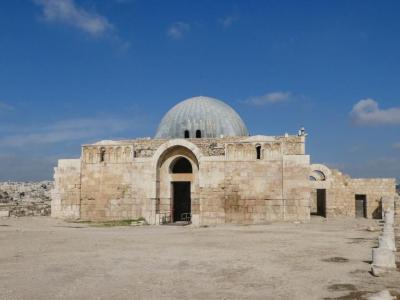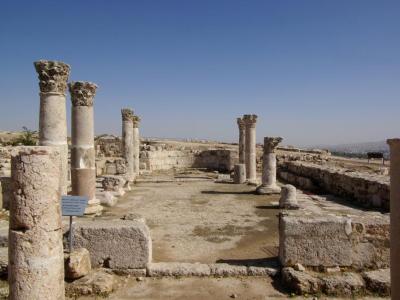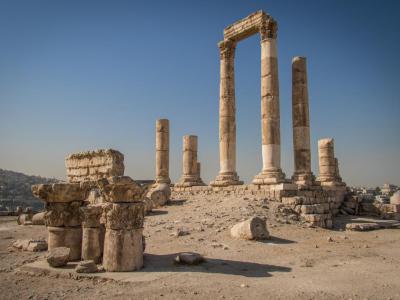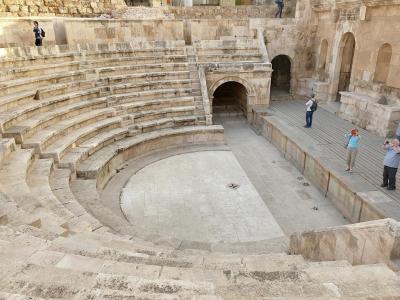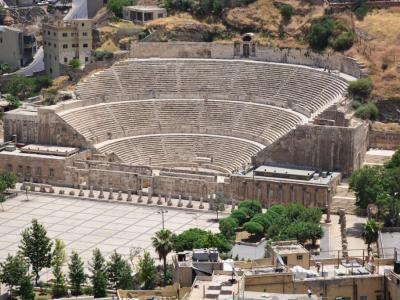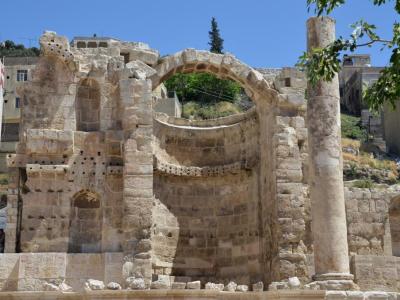Roman Ruins Walking Tour (Self Guided), Amman
Once dominated by the Romans, the modern-day Jordanian capital, Amman, still boasts that legacy. The area known as the Citadel, sitting on the highest hill in Amman, Jebel Al Qala’a, some 850 meters above sea level, offers plenty to see.
Perched atop the Citadel, the Umayyad Palace is a captivating sight. Dating back to the 8th century, it showcases intricate Islamic architecture and affords a breathtaking panorama of the city.
Nearby, the Byzantine Church Ruins provide insights into the early Christian period. The remnants of this ancient place of worship reveal ornate mosaic floors and a glimpse into the religious life of the time.
The striking Temple of Hercules, with its massive columns and imposing structure, stands as a testament to Roman engineering prowess and a symbol of the city's ancient grandeur.
Amman's Odeon Theater is a well-preserved Roman amphitheater, where visitors can imagine the performances that once graced its stage. An excellent place to appreciate the architectural and cultural heritage of the region.
Another iconic landmark, the Roman Theatre, is the crowning glory of the city's Roman past. This open-air venue has a seating capacity of 6000 and impressive acoustics.
Finally, the Roman Nymphaeum, a public fountain adorned with intricate stonework, is a beautiful example of Roman water engineering and a place where the community once gathered.
Amman's Roman ruins are a chance to connect with the roots of civilization. For anyone keen on history or simply curious about the world's heritage, this landmark area is a must-visit. So, come and immerse yourself in the ancient charm of Amman, Jordan, and experience history like never before!
Perched atop the Citadel, the Umayyad Palace is a captivating sight. Dating back to the 8th century, it showcases intricate Islamic architecture and affords a breathtaking panorama of the city.
Nearby, the Byzantine Church Ruins provide insights into the early Christian period. The remnants of this ancient place of worship reveal ornate mosaic floors and a glimpse into the religious life of the time.
The striking Temple of Hercules, with its massive columns and imposing structure, stands as a testament to Roman engineering prowess and a symbol of the city's ancient grandeur.
Amman's Odeon Theater is a well-preserved Roman amphitheater, where visitors can imagine the performances that once graced its stage. An excellent place to appreciate the architectural and cultural heritage of the region.
Another iconic landmark, the Roman Theatre, is the crowning glory of the city's Roman past. This open-air venue has a seating capacity of 6000 and impressive acoustics.
Finally, the Roman Nymphaeum, a public fountain adorned with intricate stonework, is a beautiful example of Roman water engineering and a place where the community once gathered.
Amman's Roman ruins are a chance to connect with the roots of civilization. For anyone keen on history or simply curious about the world's heritage, this landmark area is a must-visit. So, come and immerse yourself in the ancient charm of Amman, Jordan, and experience history like never before!
How it works: Download the app "GPSmyCity: Walks in 1K+ Cities" from Apple App Store or Google Play Store to your mobile phone or tablet. The app turns your mobile device into a personal tour guide and its built-in GPS navigation functions guide you from one tour stop to next. The app works offline, so no data plan is needed when traveling abroad.
Roman Ruins Walking Tour Map
Guide Name: Roman Ruins Walking Tour
Guide Location: Jordan » Amman (See other walking tours in Amman)
Guide Type: Self-guided Walking Tour (Sightseeing)
# of Attractions: 6
Tour Duration: 2 Hour(s)
Travel Distance: 3.0 Km or 1.9 Miles
Author: DanaOffice
Sight(s) Featured in This Guide:
Guide Location: Jordan » Amman (See other walking tours in Amman)
Guide Type: Self-guided Walking Tour (Sightseeing)
# of Attractions: 6
Tour Duration: 2 Hour(s)
Travel Distance: 3.0 Km or 1.9 Miles
Author: DanaOffice
Sight(s) Featured in This Guide:
- Umayyad Palace
- Byzantine Church Ruins
- Temple of Hercules
- Odeon Theater
- Roman Theatre
- Roman Nymphaeum (Public Fountain)
1) Umayyad Palace
Nestled atop the historic Amman Citadel, the Umayyad Palace stands as a testament to the architectural grandeur and cultural richness of its time. Among the structures within the Amman Citadel, the Umayyad Palace is perhaps the best-preserved and most captivating.
Believed to have been constructed during the transitional period between the 7th and 8th centuries, the Umayyad Palace is a fascinating relic of the Umayyad dynasty's rule in the region. While the palace complex once encompassed a vast expanse of buildings, the ravages of time and the unforgiving hand of nature, particularly an earthquake, have left much of it in ruins.
One of the most striking features of the Umayyad Palace is its domed audience hall, which has defied the centuries and remains in remarkably good condition. This domed hall, with its imposing and grand design, served a distinct purpose: to awe and impress visitors to the palace. Its architectural splendor stands as a testament to the craftsmanship and vision of its builders.
As one ventures deeper into the Umayyad complex, they encounter a courtyard, bearing the remnants of residential buildings that once housed the palace's occupants. The courtyard's echoes of life in centuries past provide a glimpse into the daily existence of those who inhabited this historic space.
Another integral component of the Umayyad Palace complex is the Cistern, a marvel of ancient engineering. This structure was instrumental in transporting and managing the vital resource of water within the palace. Its intricate design and functionality serve as a testament to the advanced knowledge and ingenuity of the time.
Believed to have been constructed during the transitional period between the 7th and 8th centuries, the Umayyad Palace is a fascinating relic of the Umayyad dynasty's rule in the region. While the palace complex once encompassed a vast expanse of buildings, the ravages of time and the unforgiving hand of nature, particularly an earthquake, have left much of it in ruins.
One of the most striking features of the Umayyad Palace is its domed audience hall, which has defied the centuries and remains in remarkably good condition. This domed hall, with its imposing and grand design, served a distinct purpose: to awe and impress visitors to the palace. Its architectural splendor stands as a testament to the craftsmanship and vision of its builders.
As one ventures deeper into the Umayyad complex, they encounter a courtyard, bearing the remnants of residential buildings that once housed the palace's occupants. The courtyard's echoes of life in centuries past provide a glimpse into the daily existence of those who inhabited this historic space.
Another integral component of the Umayyad Palace complex is the Cistern, a marvel of ancient engineering. This structure was instrumental in transporting and managing the vital resource of water within the palace. Its intricate design and functionality serve as a testament to the advanced knowledge and ingenuity of the time.
2) Byzantine Church Ruins
The Byzantine Church was constructed in the 6th century AD. It is characterized by its basilica plan, a hallmark of Byzantine architectural design. Its architectural layout comprises a central nave flanked by two side aisles. This arrangement created a sense of grandeur within the sacred space, allowing congregants to gather and worship in an awe-inspiring environment.
The eastern end of the church culminates in a semi-circular apse, a distinctive feature that served as a focal point for religious ceremonies and rituals. Separated from the main body of the church by a chancel screen, the apse held profound spiritual significance, and its design and decoration held deep religious symbolism.
Intriguingly, the Corinthian capitals that adorn some of the columns within the basilica were repurposed from the nearby Temple of Hercules. The aisles of the church, designed with meticulous attention to detail, feature flagstone paving that adds both practicality and aesthetic value to the sacred space. The meticulous craftsmanship of the era is evident in every stone.
Adjacent to the main basilica, one can discover rectangular rooms, which are believed to have been added by the Umayyads approximately a century later. These additions are a testament to the enduring significance of the site across different epochs.
One of the most captivating features of the Byzantine Church is its mosaic-paved nave, a characteristic feature of the Byzantine period. While the mosaic floor is now covered for protection, it harkens back to a time when the church's interior would have been adorned with intricate and colorful designs, reflecting the artistic and religious sensibilities of the era.
The eastern end of the church culminates in a semi-circular apse, a distinctive feature that served as a focal point for religious ceremonies and rituals. Separated from the main body of the church by a chancel screen, the apse held profound spiritual significance, and its design and decoration held deep religious symbolism.
Intriguingly, the Corinthian capitals that adorn some of the columns within the basilica were repurposed from the nearby Temple of Hercules. The aisles of the church, designed with meticulous attention to detail, feature flagstone paving that adds both practicality and aesthetic value to the sacred space. The meticulous craftsmanship of the era is evident in every stone.
Adjacent to the main basilica, one can discover rectangular rooms, which are believed to have been added by the Umayyads approximately a century later. These additions are a testament to the enduring significance of the site across different epochs.
One of the most captivating features of the Byzantine Church is its mosaic-paved nave, a characteristic feature of the Byzantine period. While the mosaic floor is now covered for protection, it harkens back to a time when the church's interior would have been adorned with intricate and colorful designs, reflecting the artistic and religious sensibilities of the era.
3) Temple of Hercules
The Temple of Hercules is hailed as one of the most significant Roman structures nestled within the Amman Citadel, echoing the city's rich history and architectural grandeur.
Historical records suggest that the construction of the Temple of Hercules can be attributed to the reign of Geminius Marcianus, who held the position of governor of the Province of Arabia during the years AD 162–166. This timeline places the temple's creation in parallel with another iconic Roman marvel in Amman, the Roman Theater.
The temple's footprint measures approximately 30 by 24 meters (98 by 79 feet), while the outer sanctum encompasses a vast area measuring 121 by 72 meters (397 by 236 feet). An imposing portico, graced by six majestic columns standing at an impressive height of approximately 10 meters (33 feet), welcomes visitors to this historical treasure.
As historians and archaeologists delve into the temple's past, they believe that the absence of additional columns hints at an unfinished construction. It is speculated that the marble intended for completing the temple may have been repurposed for the nearby Byzantine Church, further adding to the historical intrigue of the site.
One of the most captivating features of the Temple of Hercules is the discovery of fragments belonging to a colossal statue, unmistakably identified as Hercules himself. This imposing figure is estimated to have once stood tall, soaring over 12 meters (39 feet) in height. Regrettably, the ravages of time, possibly exacerbated by seismic activity, have left us with only remnants, including three fingers and an elbow, as hauntingly beautiful reminders of the past.
Historical records suggest that the construction of the Temple of Hercules can be attributed to the reign of Geminius Marcianus, who held the position of governor of the Province of Arabia during the years AD 162–166. This timeline places the temple's creation in parallel with another iconic Roman marvel in Amman, the Roman Theater.
The temple's footprint measures approximately 30 by 24 meters (98 by 79 feet), while the outer sanctum encompasses a vast area measuring 121 by 72 meters (397 by 236 feet). An imposing portico, graced by six majestic columns standing at an impressive height of approximately 10 meters (33 feet), welcomes visitors to this historical treasure.
As historians and archaeologists delve into the temple's past, they believe that the absence of additional columns hints at an unfinished construction. It is speculated that the marble intended for completing the temple may have been repurposed for the nearby Byzantine Church, further adding to the historical intrigue of the site.
One of the most captivating features of the Temple of Hercules is the discovery of fragments belonging to a colossal statue, unmistakably identified as Hercules himself. This imposing figure is estimated to have once stood tall, soaring over 12 meters (39 feet) in height. Regrettably, the ravages of time, possibly exacerbated by seismic activity, have left us with only remnants, including three fingers and an elbow, as hauntingly beautiful reminders of the past.
4) Odeon Theater
Nestled perpendicular to the axis of the majestic Roman Theater and gracefully framing the eastern bounds of the Roman Forum, stands the enchanting Odeon Theater. This smaller yet equally significant theater, dating back to the 2nd century AD, has carved its own place in history as a venue for various cultural and intellectual pursuits.
The Odeon is a testament to Roman architectural ingenuity and has been meticulously preserved over the centuries. Its semicircular seating area, adorned with rows of seating, offers a cozy setting with the capacity to accommodate approximately 500 individuals across nine tiers. Originally, it is believed that the theater was covered with an ornate wooden roof, adding to its grandeur and providing shelter for its audiences.
The stage building, a focal point of the Odeon, once boasted intricate embellishments, including ornate friezes and niches that celebrated the performing arts and culture of its time. An interior gangway, artfully vaulted, connects the stage area to the rest of the theater through three gracefully designed doorways.
Today, the Odeon Theater continues to play a vital role in Amman's cultural landscape, hosting a diverse range of events and performances. Music, poetry readings, debates, lectures, and more come to life within these ancient walls, echoing the intellectual and artistic traditions of centuries past. Notably, the Odeon takes center stage during the annual Al Balad Music Festival, captivating audiences with its enduring charm and cultural significance.
The Odeon is a testament to Roman architectural ingenuity and has been meticulously preserved over the centuries. Its semicircular seating area, adorned with rows of seating, offers a cozy setting with the capacity to accommodate approximately 500 individuals across nine tiers. Originally, it is believed that the theater was covered with an ornate wooden roof, adding to its grandeur and providing shelter for its audiences.
The stage building, a focal point of the Odeon, once boasted intricate embellishments, including ornate friezes and niches that celebrated the performing arts and culture of its time. An interior gangway, artfully vaulted, connects the stage area to the rest of the theater through three gracefully designed doorways.
Today, the Odeon Theater continues to play a vital role in Amman's cultural landscape, hosting a diverse range of events and performances. Music, poetry readings, debates, lectures, and more come to life within these ancient walls, echoing the intellectual and artistic traditions of centuries past. Notably, the Odeon takes center stage during the annual Al Balad Music Festival, captivating audiences with its enduring charm and cultural significance.
5) Roman Theatre (must see)
The Roman Theatre of Amman, a magnificent structure dating back to the 2nd century, stands as a prominent historical gem in the Jordanian capital. This iconic landmark is a testament to the city's rich Roman heritage, back when it was known as Philadelphia.
Positioned strategically in the eastern part of Amman, the Roman Theatre rests at the base of Jabal Al-Joufah, nestled on a hill opposite the Amman Citadel. An inscription in Greek on one of its pillars proudly declares that the theatre was erected in honor of Emperor Antoninus Pius (138–161 CE).
The theatre's impressive design features a large and steeply raked seating arrangement that could accommodate approximately 6,000 spectators. Ingeniously carved into the hillside, it was oriented to the north to shield the audience from the sun's glare.
Structured into three distinct horizontal sections known as diazomata, the theatre featured side entrances, or paradoi, at ground level. One led to the orchestra, while the other provided access to the stage area. Today, these entrances house the Jordan Museum of Popular Tradition on one side and the Jordan Folklore Museum on the other.
Notably, the highest section of seats in the theatre, often referred to as "the gods" in British English, offers excellent sightlines despite its distance from the stage. The steepness of the seating arrangement ensures that the actors' performances can be heard with remarkable clarity.
Today, the Roman Theatre serves as a vibrant venue for cultural events, reflecting its enduring role in the life of Amman. It has hosted diverse activities, including the Amman International Book Fair, the Amman Marathon prize ceremony, and musical concerts, such as the renowned Al-Balad Music Festival. In August 2019, the American rapper Russ held a concert at this historic venue, breathing new life into its ancient stones with the beats of modern music.
Positioned strategically in the eastern part of Amman, the Roman Theatre rests at the base of Jabal Al-Joufah, nestled on a hill opposite the Amman Citadel. An inscription in Greek on one of its pillars proudly declares that the theatre was erected in honor of Emperor Antoninus Pius (138–161 CE).
The theatre's impressive design features a large and steeply raked seating arrangement that could accommodate approximately 6,000 spectators. Ingeniously carved into the hillside, it was oriented to the north to shield the audience from the sun's glare.
Structured into three distinct horizontal sections known as diazomata, the theatre featured side entrances, or paradoi, at ground level. One led to the orchestra, while the other provided access to the stage area. Today, these entrances house the Jordan Museum of Popular Tradition on one side and the Jordan Folklore Museum on the other.
Notably, the highest section of seats in the theatre, often referred to as "the gods" in British English, offers excellent sightlines despite its distance from the stage. The steepness of the seating arrangement ensures that the actors' performances can be heard with remarkable clarity.
Today, the Roman Theatre serves as a vibrant venue for cultural events, reflecting its enduring role in the life of Amman. It has hosted diverse activities, including the Amman International Book Fair, the Amman Marathon prize ceremony, and musical concerts, such as the renowned Al-Balad Music Festival. In August 2019, the American rapper Russ held a concert at this historic venue, breathing new life into its ancient stones with the beats of modern music.
6) Roman Nymphaeum (Public Fountain)
The Nymphaeum, a captivating vestige of Roman architecture and ingenuity, graces the heart of Amman bearing witness to the city's rich historical tapestry. Nestled near the Hashemite Plaza and in close proximity to the Roman Theater and the Odeon, this partially preserved Roman public fountain serves as a poignant reminder of the grandeur of ancient Philadelphia, the name by which Amman was known during antiquity.
Roman cities were renowned for their ornate and functional public fountains, and Amman was no exception. The Nymphaeum, believed to have been constructed in the 2nd century CE, during the same era as the neighboring theater and odeon, showcases the architectural prowess of its time.
This splendid nymphaeum is thought to have once featured an expansive pool, stretching across an impressive 600 square meters and reaching a depth of three meters. In its heyday, this remarkable structure was continuously replenished with fresh, flowing water, creating a captivating oasis in the heart of the ancient city.
Over the centuries, the Nymphaeum has endured the passage of time, but erosion, cracking, and flaking have taken their toll on this magnificent relic. However, the story of the Nymphaeum did not end there. In a testament to the enduring spirit of preservation and discovery, a dedicated team of archaeology students from esteemed institutions such as the University of Jordan, Petra University, and the Hashemite University, along with skilled technicians, embarked on a mission to restore this ancient gem.
With the generous support of the U.S. embassy, the restoration efforts commenced in September 2015. The meticulous work involved cleaning the structure stone by stone, a labor of love that aimed to revive the Nymphaeum's former glory. Portions of stone that had succumbed to the ravages of time were carefully replaced, allowing visitors to once again witness the resplendent beauty of this ancient marvel.
Roman cities were renowned for their ornate and functional public fountains, and Amman was no exception. The Nymphaeum, believed to have been constructed in the 2nd century CE, during the same era as the neighboring theater and odeon, showcases the architectural prowess of its time.
This splendid nymphaeum is thought to have once featured an expansive pool, stretching across an impressive 600 square meters and reaching a depth of three meters. In its heyday, this remarkable structure was continuously replenished with fresh, flowing water, creating a captivating oasis in the heart of the ancient city.
Over the centuries, the Nymphaeum has endured the passage of time, but erosion, cracking, and flaking have taken their toll on this magnificent relic. However, the story of the Nymphaeum did not end there. In a testament to the enduring spirit of preservation and discovery, a dedicated team of archaeology students from esteemed institutions such as the University of Jordan, Petra University, and the Hashemite University, along with skilled technicians, embarked on a mission to restore this ancient gem.
With the generous support of the U.S. embassy, the restoration efforts commenced in September 2015. The meticulous work involved cleaning the structure stone by stone, a labor of love that aimed to revive the Nymphaeum's former glory. Portions of stone that had succumbed to the ravages of time were carefully replaced, allowing visitors to once again witness the resplendent beauty of this ancient marvel.
Walking Tours in Amman, Jordan
Create Your Own Walk in Amman
Creating your own self-guided walk in Amman is easy and fun. Choose the city attractions that you want to see and a walk route map will be created just for you. You can even set your hotel as the start point of the walk.
Amman Introduction Walking Tour
The capital of Jordan, Amman, is a city that successfully marries rich history with the bustling vibrancy of a modern metropolis. A place where ancient tales and contemporary life intersect.
The earliest evidence of human settlement in the area dates back to the 8th millennium BC. Initially, in the second millennium BC, the city was known as Rabat Aman and served as the capital of the Ammonite... view more
Tour Duration: 2 Hour(s)
Travel Distance: 4.3 Km or 2.7 Miles
The earliest evidence of human settlement in the area dates back to the 8th millennium BC. Initially, in the second millennium BC, the city was known as Rabat Aman and served as the capital of the Ammonite... view more
Tour Duration: 2 Hour(s)
Travel Distance: 4.3 Km or 2.7 Miles
The Most Popular Cities
/ view all



